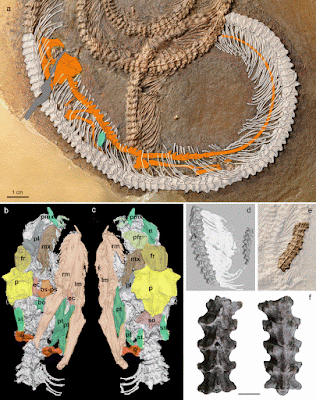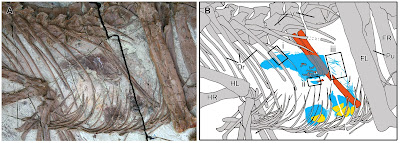 |
| Fig 1. from Smith and Scanferla 2016. |
 |
| Fig. 2 from Smith and Scanferla 2016. |
 |
| Fig 4. from Walker and Everhart 2006. The impossible fossil - revisited. |
2) Dinosaur eating mammal
 |
| Fig 3. from Hu et al., 2005. Large Mesozoic mammals fed on young dinosaurs |
3) Dinosaur eating dinosaur
 |
| Fig 1 and 5 from Xing et al., 2012. Abdominal Contents from Two Large Early Cretaceous
Compsognathids (Dinosauria: Theropoda) Demonstrate Feeding on
Confuciusornithids and Dromaeosaurids |
4) Birds have long eaten seeds
 |
| Fig 1a. from Zhou and Zhang, 2002. A long-tailed, seed-eating bird from the Early Cretaceous of
China |
This large early bird from the Jehol of China (Jeholornis prima) preserves a mass of over 50 seeds (the small round things lower centre of the image) in its guts. Whilst this may not seem that exciting, new research this year suggests the ability to process seeds may be important in the survival of birds when the dinosaurs died out.
5) Deinocheirus ate fish?
 |
| Extended data Fig 7 from Lee et al., 2014. Resolving the long-standing enigmas of a giant
ornithomimosaur Deinocheirus mirificus |
Anyone who has read the blog for a while knows I've got a soft spot for ornithomimosaurs because I did my PhD on them. They are an incredibly strange group that loses their teeth and evolve beaks, and this change (and a bunch of others) has been linked to a change in diet from carnivory to herbivory. The massive, and now with a body, Deinocheirus seems to have gastroliths for eating plant materials, but also preserves fish bones within its stomach. Whether this was deliberate hunting of fish, accidental ingestion of them, or one of the many other ways for fish remains to end up there, is still uncertain. With more fossils will hopefully be more clarity on the matter.
There are countless other ones I could have picked. Whether it was ichthyosaurs with belemnite hooklets, or other dinosaurs and mammals with their various prey/flora gut contents. If you have any amazing ones, let me know and I am happy to add them in after.

No comments:
Post a Comment